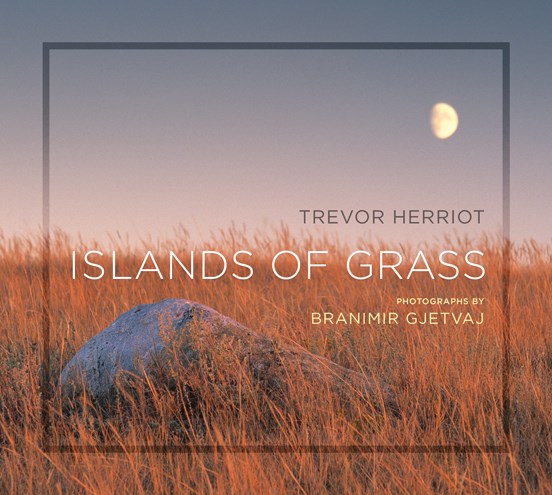Naturalist and activist, Trevor Herriot also has a growing list of books to his name.
Among them is a collaborative work with acclaimed nature photographer Branimir Gjetvaj, Islands of Grass, a book Herriot will highlight in a presentation at the Yorkton Public Library Saturday at 2 p.m.
“Islands of Grass is a beautiful, well-researched call-to-action and a passionately wrought love letter to the prairie grasslands that are rapidly disappearing in the wake of modernity’s relentless push,” details www.coteaubooks.com, (the book’s publisher).
“Before the arrival of settlers, the Great Northern Plain sprawled across the centre of the continent and rivalled the African savannah for wildlife, with herds of bison and pronghorn antelope numbering in the millions. It was also the home for species of birds and animals that lived nowhere else.
“Today that range is threatened by human incursion and in some areas there are only pockets of unadulterated prairie grassland left, small islands of a unique environment. In those small plots of grasslands species cling to survival, unable to thrive in any other environment.
“In presenting the irreplaceable beauty and the complexity of the grasslands, Trevor and Branimir ask the reader to both admire its majesty and consider its value. Full of extraordinary photos supported by the thought-provoking prose of Trevor Herriot, this book will bring the wonder of the grasslands to a wider audience.”
Herriot told Yorkton This Week the book “came about almost by coincidence,” with he and Branimir deciding to team-up to create what turned out to “more of a coffee table book.”
Herriot said he was aware Branimir “was taking photos of grassland regions in Canada and the United States.” Then in 2015 the pair ended up driving around to different grassland spots and the book just sort of became a natural thing to pursue.
The result is a book in which Herriot contributes five short essays, each about 5,000 words, on various aspects of the grasslands story. The essays are supported by Branimir’s photography.
Herriot said he went into the project with a rather defined idea in regards to what he was going to focus on.
“I knew what I wanted to write about,” he said, adding it was then a case of working with Branimir to select the best photos to support each essay.
In terms of approach Herriot said he wanted “to tell human stories.” He noted that while he wanted to tell stories of landscapes and ecosystems that was impossible without including the impact of people whether that was the indigenous peoples, the time of open range grazing of native grasslands, or the move to cultivate grasslands for grain production.
Everything has a human element, said Herriot. “That’s how I find it works when writing about nature.”
Through the essays Herriot said he tries to inform readers about what is being lost when natural grasslands are destroyed.
“It’s part of our mission … to help people to understand,” he said.
A natural grassland is something that has lasted thousands of years, supporting a diverse populations of plants, insects and wildlife, and if lost it can’t simply be replanted. In fact, efforts to create new grasslands have never managed to support the biodiversity achieved over hundreds of years, he said.
“We want to wake people up to seeing the value of grasslands,” he said, adding there needs to be education now before all the natural grasslands are gone.
As it is there is less than 20 per cent of old growth grasslands remaining, and in some areas the numbers are worse. In southwest Saskatchewan there may still be 30-35 per cent of old growth grasslands still surviving, offered Herriot, but in the aspen parkland area the number is only 10 per cent.
Herriot said in general “people want to be able to help,” he said, adding “they don’t like living in a sacrifice zone.”
But change will not come easily as there is a push for grain land to produce food, admitted Herriot, adding it will take a concerted effort to find ways to feed people that are not “so harmful to natural ecosystems.”
As noted Herriot has written a number of books including The Road is How: A Prairie Pilgrimage through Nature, Desire, and Soul published by HarperCollins in April, 2014, and nominated for three Saskatchewan Book Awards.
Grass, Sky, Song: Promise and Peril in the World of Grassland Birds (HarperCollins, 2009) was a Globe & Mail Top 100 book, was listed by Quill and Quire on its 2009 list of 15 books that matter, and shortlisted for the Writer’s Trust Non-Fiction Prize, the Governor General’s Award for Non-fiction, and the William Saroyan International Prize for Writing (non-fiction).
Herriot’s first book, River in a Dry Land: a Prairie Passage (2000), received several national awards and a nomination for the Governor General’s Award for Non-Fiction.
And his second book, Jacob’s Wound: a Search for the Spirit of Wildness (2004), was nominated for several awards, including a short-listing for the Writer’s Trust Award for Non-Fiction. His writing has appeared in the Globe & Mail and Canadian Geographic, as well as several anthologies.
Readers can stay on top of what Herriot is up to as he posts regularly on his grassland blog, Grass Notes, at trevorherriot.blogspot.com




